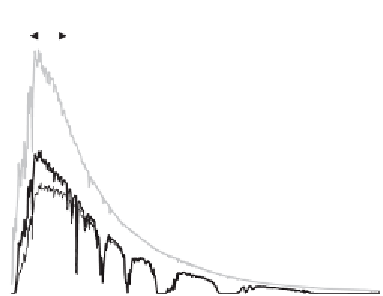Geoscience Reference
In-Depth Information
2.5
visible
TOA
total
direct
diffuse
2.0
1.5
1.0
0.5
0.0
0.5
1.0
1.5
2.0
2.5
3.0
Wavelength(µm)
Figure 2.7
Spectral composition of shortwave radiation on May 23, at 52°N, 5°E:
at top of atmosphere (TAO), and at ground level: global radiation (total), direct and
diffuse radiation. The TAO spectrum is due to Gueymard (
2004
); the ground level
data are based on model calculations with SMARTS version 2.9 (Gueymard,
2001
),
applied to a US standard atmosphere.
(blue) relative to the radiation at the top of the atmosphere, whereas the direct radi-
ation has shifted in the direction of higher wavelengths (yellow and red) as a result
of the wavelength dependence of Rayleigh scattering. These shifts result in the blue
colour of the hemisphere (diffuse radiation) and the yellowish colour (at sunset and
sunrise reddish) of the Sun (direct radiation).
Global Radiation
In the preceding analysis we have taken into account the directional and spectral
composition of the radiation reaching the surface. But in the context of the surface
energy balance we are interested in the total amount of solar radiation that reaches
the surface (global radiation):
K
↓
. Thus, to obtain
K
↓
all radiation reaching the surface
has to be integrated over the spectral range of solar radiation and over all directions
in vertical (
θ
z
) and horizontal (
ϕ
, azimuth angle).
In the context of global radiation, two other transmissivities are useful to deine.
First, the broadband beam transmissivity
τ
b
θ
(the broadband equivalent of spectral
beam transmissivity; see Eq. (
2.14
)) is deined as:
τ
b
≡
I
I
0
,
(2.15)
where
I
0
is the radiation lux density at the top of the atmosphere, through a plane
perpendicular to the beam. This transmissivity is useful in those cases in which a
































Search WWH ::

Custom Search